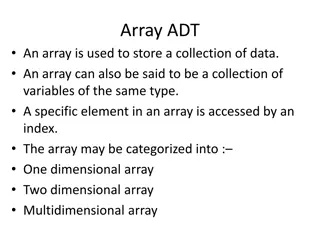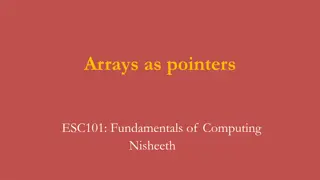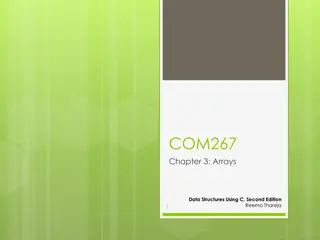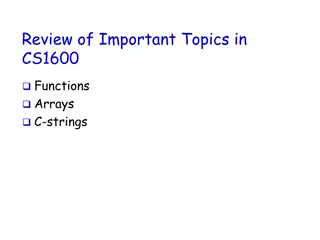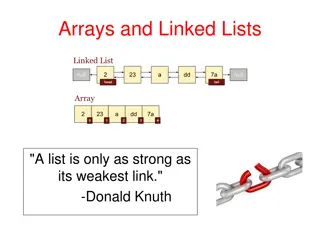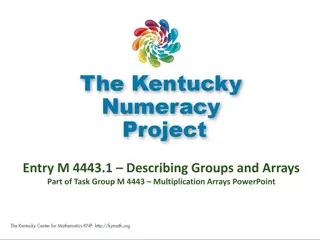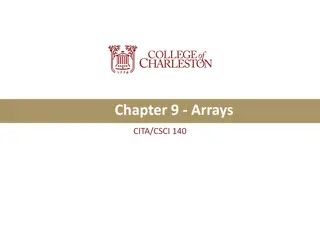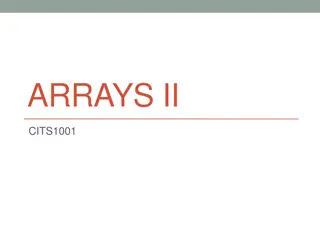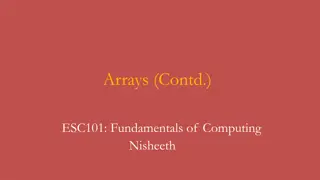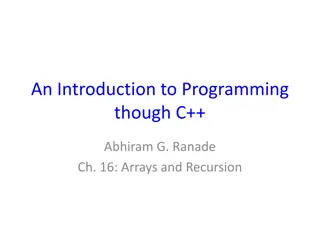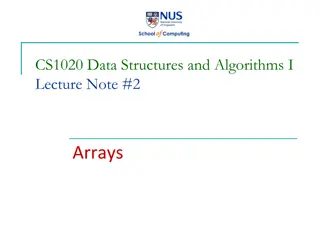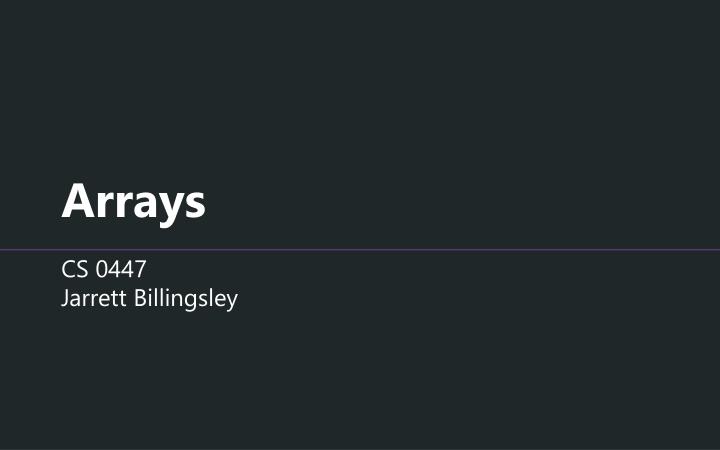
Arrays in Computer Science
Arrays in computer science are a fundamental concept for organizing and storing data efficiently. They consist of a sequence of variables of the same type, equidistant in memory. This allows for fast access to elements and efficient manipulation of data. Learn about array slots, variable declarations, memory addresses, and more in this comprehensive guide.
Download Presentation

Please find below an Image/Link to download the presentation.
The content on the website is provided AS IS for your information and personal use only. It may not be sold, licensed, or shared on other websites without obtaining consent from the author. If you encounter any issues during the download, it is possible that the publisher has removed the file from their server.
You are allowed to download the files provided on this website for personal or commercial use, subject to the condition that they are used lawfully. All files are the property of their respective owners.
The content on the website is provided AS IS for your information and personal use only. It may not be sold, licensed, or shared on other websites without obtaining consent from the author.
E N D
Presentation Transcript
Arrays CS 0447 Jarrett Billingsley
Class announcements ghfhfhlnnnnnnffghh CS447 2
Arrays CS447 3
What's an array? I mean more existentially. first let's think about variables. what can you do with them? now let's think about array slots. (or items, or elements, or whatever) var = 10; print(var); var++; p = &var; a[i] = 10; print(a[i]); a[i]++; p = &a[i]; (in C, &var gets var's address.) they're both places where you can store one value. CS447 4
All made out of ticky-tacky imagine you're walking down the street in a city neighborhood. they're equidistant. they're a constant distance d apart. 129 121 125 127 123 d YOU ARE HERE 3d if you are at 121, and you want to get to 127 how far do you travel? CS447 5
Declaring multiple variables let's see what the assembler does if we declare 5 variables in a row. look at their addresses in the labels window. 0x10010000 0x10010004 0x10010008 0x1001000C 0x10010010 .data a: .word 1 b: .word 2 c: .word 3 d: .word 4 e: .word 5 12 in hexadecimal 16 in hexadecimal addresses are a measure of bytes... each word is 32 bits (4 bytes)... so each variable is given 4 bytes of space to "live." CS447 6
Howdy, neighbor addresses are "just numbers." we can get the address of a label in MIPS with la: la t0, a # in C, t0 = &a o now t0 contains a's address, 0x10010000. o la does not load anything from memory! if I want to calculatec's address from this, what do I add? 01 00 00 00 02 00 00 00 03 00 00 00 YOU ARE HERE c how many "doors away" is it? CS447 7
Arrays == spooning variables an array is a sequence of variables where: o each variable is the same type, and therefore the same size. o so, they are equidistant in memory. each array slot's address can be calculated by: o starting at the first (0th) variable's address; o then adding a multiple of the size of one variable. 0x10010000 0x10010008 0x1001000C 0x10010010 0x10010004 a[0] a[1] a[2] a[3] a[4] CS447 8
Why do we do this? we represent them like this because it's fast. it doesn't matter if you're accessing the 1st, or the 5th, or the 5000th element, the address calculation is always the same: the address of A[i] is A + S i where A is the Array's Address(address of item 0) S is the Sizeof each itemin bytes and i is the indexof the itemyou want to access. this calculation can be done in constant time. CS447 9
Arrays in MIPS CS447 10
Making an array (animated) making an array is just like making variables, except .data a: .word b: c: d: e: .word 1 2 3 4 5 you only label the first value. you only need .word once. and you can put all the values on one line, if you want. .word .word .word no, not like that CS447 11
Intermission: for loops for loops are like while loops with a loop counter variable. for(t0 = 0; t0 < 10; t0++) { li t0, 0 _loop: add t0, t0, 1 blt t0, 10, _loop for for-loops that always run one or more times, which is almost all of them, this way of writing them works fine! body body } but you could get into trouble if 0 iterations is possible CS447 12
Array address calculation you know the formula (A + S i) you know the Size of the items (S = 4 bytes) you know how to get the base address A (with la) let's do this: print(a[i]) (where i is in t0) la t1, a # t1 = A (A = a's addr) mul t2, t0, 4 # t2 = Si (S = 4, i = t0) add t1, t1, t2 # t1 = A + Si lw a0, ____ wait wait how CS447 13
Loads and stores to calculated addresses to load from an address in a register, use this form of lw: lw a0, (t1) # load from address held in t1 li v0, 1 syscall # print a[i]! there's a corresponding form of sw if you want to do, say, a[i] = 7: # assuming we calculated the address into t1 li t2, 7 sw t2, (t1) # store into address held in t1 t1 is not affected by these instructions! o the (parentheses) say to access memory at this address o lw and sw always copy between registers and memory let's run through a few examples of calculating array item addresses for some different sizes of values CS447 14
But that's kind of a pain, huh. there's a shorter way to do this, with the final form of lw/sw. # print(arr[i]) la t1, arr mul t2, t0, 4 add t1, t1, t2 lw a0, (t1) li v0, 1 syscall # print(arr[i]) mul t1, t0, 4 this form says, "load a word from arr + t1". it lets you skip the la and add steps entirely! lw a0, arr(t1) li v0, 1 syscall but don't forget: you still have to multiply the index by the size of one item. mul t1, t0, 4 li t2, 7 sw t2, arr(t1) it works with sw too: CS447 15
Im just gonna drill this in here this syntax looks weird, but it is doing an addition! does: does: lw t0, arr(t1) t0 = MEMORY[arr + t1] sw t0, arr(t1) MEMORY[arr + t1] = t0 arr(t1) means arr + t1 and I have no clue where they got this syntax but MIPS is not the first or last architecture to use it and it s confusing but there it is. despite that, I recommend you use it, cause it s shorter than the la-add stuff, and shorter code = less stuff to think about = fewer mistakes. 16 CS447
Alignment CS447 17
*bonk* you're on the street again. you start at house 121. 129 121 125 127 123 YOU ARE HERE 2.5d but this time, you only walk 2.5 times the distance between houses, and try to go inside. CS447 18
*bonk*, but in MIPS let's try this: li t0, 3 # NOT a multiple of 4 lw t1, a(t0) what happens when we run this? o crash: load address not aligned on word boundary 0x10010003" o and the error points to our lw line. this is a memory alignment error. CS447 19
Uh oh, another glowing definition memory alignmentmeans the address of an n-byte value must be a multiple of n 8-byte values must be at addresses that are multiples of 8. 4-byte values must be at addresses that are multiples of 4. 2-byte values must be at addresses that are multiples of 2. 1-byte values must be at addresses that are multiples of 1? (yes, any address is OK for a 1-byte value) CS447 20
Why does alignment exist? long story short: it makes memory accesses faster. short story long (but not important, don't study this): o physically, memory is implemented as a 2D grid of bits o memory accesses must happen one "row" at a time as an example, if each row is 32 bits o an unaligned word access will overlap two rows o which is possible to solve, but makes the memory hardware much more complex and slower, and now some memory accesses are faster than others o SOOOOOOOoooooooooo we just ban it. on MIPS. but not on all architectures. but MIPS also has separate unaligned load/store instructions. don'worryaboudit CS447 21
Accessing non-word variables for the same reason Java has more flavors of integer than int o MIPS has more flavors of load and store than lw/sw. Java declaration MIPS declaration Load/store with lb/lbu and sb lh/lhu and sh byte b = 100; b: .byte 100 short s = 1000; s: .half 1000 these versions of load and store have the same alternate forms too, e.g. sb t0, (t1) but what the heck are lbu and lhu about? CS447 22
Remember extension? a byte is 8 bits. a MIPS register is 32 bits. so if we load a byte into a register we have to fill in the extra bits. 31 0 10010000 00000000 00000000 00000000 00000000 If the byte is signed what should it become? lbdoes sign extension. 31 11111111 11111111 11111111 10010000 If the byte is unsigned what should it become? 0 31 0 lbu does zero extension. 00000000 00000000 00000000 10010000 lhand lhubehave similarly. CS447 23
Storing bytes and half-words when we store, we will have to leave some bits behind, so the stored value is truncated. sh 31 31 0 0 11001000 00000100 11111111 11111111 11001000 00000100 11111111 11111111 11001000 00000100 because we're going from a larger number of bits to a smaller number of bits, all the leading 1s/0s can be left behind therefore, there are no sbu/shuinstructions but remember: truncating a value too far can give incorrect results! CS447 24
Endianness CS447 25
A matter of perspective let's say there's a word at address 4. what word do those 4 bytes represent? if we think of addresses increasing downward, and read top to bottom if we think of addresses increasing upward, and read top to bottom Addr Val Addr Val ... ... 0004 DE 0007 BE 0005 C0 0006 EF 0006 EF 0005 C0 is it is it 0007 BE 0004 DE 0xBEEFC0DE? 0xDEC0EFBE? ... ... CS447 26
Endianness remember how the CPU "chops up" and "reassembles" values larger than a byte when loading and storing? endianness is what rule it uses to decide which byte goes first. looking at the memory horizontally Addr 00 01 02 03 04 05 06 07 Val 05 00 00 00 DE C0 EF BE t0 0x00000005 t0 0xDEC0EFBE a little-endian CPU "swaps the order" of the bytes. a big-endian CPU "keeps them in order". CS447 27
Which is better: little or big? as long as you're consistent, it doesn't matter o but most computers in common use today are little-endian. endianness is kind of like which side of the road you drive on. some countries chose left and some chose right, and all that matters is that everyone agrees to drive on the same side. endianness pops up whenever you have sequences of bytes. o not just memory, but also files and networking. which one is MIPS? o it's bi-endian can work in either configuration o but MARS uses the endianness of the computer it's running on so little-endian for everyone. CS447 28

